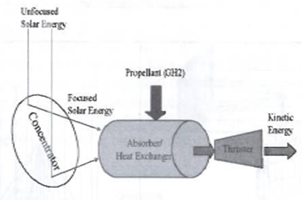Solar Thermal Propulsion
Introduction
The concept of solar thermal propulsion stems from the better known solar-dynamic power system. This propulsion system has been proposed as an alternative means of rocket propulsion for orbit transfer and planetary missions. In this system, solar energy is accumulated by an absorber and is used to burn propellant during the thrust phase.
Concept of Solar Thermal Propulsion

Solar thermal propulsion concept
In general, solar thermal propulsion utilises solar light to heat a propellant up to 2000 K. The gaseous propellant is then fed through a conventional rocket nozzle to produce thrust. A solar propelled rocket only needs a means by which it can capture solar energy. No electrical generator is needed. The thrust of the engine is dependent on the surface area of the solar collector (concentrators and mirrors) and the local intensity of the solar radiation. Light is collected by a parabolic reflector and then focused onto a blackbody cavity to generate a high internal temperature. Here, heat is transferred to the propellant to produce thrust. The best performance can be achieved with hydrogen because of its low molecular weight.
Concentrators
Concentrators are used to collect solar light and to focus it into a receiver/absorber. Large collector surfaces in the range of several square meters are needed to produce the required thermal energy. A desired solar power input will be about 1350 W/m². This is typically realised by the primary concentrators and thus, they are considered to be the most technologically demanding part of the concentrator system.
Absorber/Receiver
The function of the absorber/receiver is to absorb and transfer the energy of the concentrated solar radiation to the propellant. A heat exchanger is employed in the heating of the propellant. The transfer of energy can be achieved either continuously or after accumulation.
Performance
Solar thermal propulsion performance is in between that of conventional propulsion and ion drive propulsion. For indirect solar heating, the design cannot achieve specific impulses of more than 900 s. This is because there are some limitations to the temperature that the heat exchanger material can withstand. For direct solar heating, direct heat absorption allows higher propellant temperatures and hence has higher specific impulses of approximately 1200 s.
However, only indirect solar thermal heating has been experimentally tested. This was carried out by the United States Air Force Rocket Propulsion Laboratory using small-scale models.
Applications
Solar thermal propulsion could be applied in two particular areas: Earth-orbit transfer and scientific interplanetary missions.
Orbit Transfer Stage
The major application of commercial solar thermal propulsion is the orbital transfer of big communication satellites from low to geosynchronous Earth orbits. Multiple ignitions seem to be the most promising method for orbital transfer. This requires 11.5 tons of liquid hydrogen, producing a specific impulse of 750 s.
Interplanetary Spacecraft
Solar thermal propulsion systems can be used for interplanetary missions. In such missions, large arcs of solar concentrators are used to accurately focus sunlight onto the absorber. The heat is then transferred directly to the propellant, creating a continuous thrust to power the system. Such a method affords a higher efficiency of conversion of solar light to energy.
Comparisons have been made between conventional chemical propulsion and solar thermal propulsion. In the example of a Pluto flyby mission, it has been shown that a larger payload can be carried using solar thermal propulsion with the same amount of propellant. As such mission cost can be reduced.
Conclusion
Solar thermal propulsion is a promising rocket drive which has the potential to reduce the launch costs of commercial satellites and to raise performance for interplanetary missions. However, the development of key technologies is necessary before operational systems can be built. These include improvements in the heat capacity of heat exchangers, lightweight and rigid structures and the capability to store cryogenic hydrogen.
Currently, the best utilisation of solar thermal propulsion lies in commercial satellites and any future developments in this area is likely to hinge on the cost of this propulsion. Space performance has thus been traded for lowered cost.
Bibliography
- Accettura, A., and Ferretti, A., "PROPULSION 2000 PROGRAM, Phrase 1," Final Rep., AVIO, Colleferro (Rome), Italy, NTEPRP 10000, Nov. 2000
- Wikipedia. "Solar Thermal Rocket" <http://en.wikipedia.org/wiki/Solar_thermal_rocket>
- Claudio Bruno. "Advanced Propulsion Systems and Technologies. Today to 2020", American Institute of Aeronautics and Astronautics, Inc, 2008
- Kauffmann, J., "Solar Thermal Orbital Transfer Stage Study, Mission Analysis," DLR Cologne, 2002
- "NN: EADS-LV Executive Summary STOTS," ESA-ESTEC, Sept 2002
- E. M. Goodger. Principles of Spaceflights Propulsion. Pergamon Press, 1970





